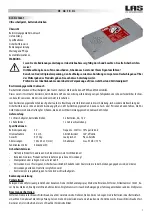
5
Maintenance Basics
Pressure relief valve maintenance should only
be performed by trained and qualified personnel
using proper test equipment. Repairs by
unqualified personnel or use of improper test equipment may lead to
poor valve performance.
These basic instructions apply to all Farris valve
series. They do not provide information specific
to product lines. For more detailed maintenance
instructions, please consult the appropriate
manuals for the valve under consideration. As
a general rule, these procedures apply to all
pressure relief valves:
Proper personal protective equipment (PPE)
should be used.
Before repairing or servicing a valve,
depressurize the system.
For valves, that have been in service, a review of the material safety
data sheet (MSDS) of process effluent should be done prior to
disassembly. Proper controls should be in place to address potential
exposures to hazardous substances, including gases, liquids, process
media, or process by-products contained in the valve.
External surfaces of the valve, including flange face surfaces and
threaded connections, should be examined for any signs of damage
or rough handling.
Completely disassemble the valve and thoroughly clean all parts.
Parts should be examined for signs of corrosion or excessive wear.
Particular attention should be given to ensure all threads are clean
and free of burrs.
Examine the stem to ensure it is straight.
Lap the nozzle seat and disc seating surfaces
to a flat mirror finish.
Reassemble valve making sure to lubricate all
threaded and bearing surfaces.
Standard repair procedure requires that all
gaskets and soft goods such as O-ring seals be
replaced with new parts.
Valve should be calibrated to the set pressure indicated on the
nameplate unless a new pressure is required. When the set pressure
is being changed maintenance personnel must confirm if the existing
spring is acceptable or if a new spring is required.
Testing must only be performed using the correct test fluids. Air, gas
and vapor service valves must be tested using air as the test fluid, liquid
service valves should be tested on water, and steam service valves
must be tested on steam.
Note:
For pilot operated relief valves on liquid service, introducing
liquid into the dome area of the main valve and pilot assembly during
maintenance testing may cause problems when placed in service. The
setting and testing of the pilot control may be done separately from the
main valve on the proper fluid. An air test may be substituted to confirm
valve functions, but set pressures may vary from actual setting due to
the difference in test media.
Set pressure testing must be performed first, followed by seat leakage
testing. Seat leakage testing is performed at 90% of set pressure. For
valves set at 50 psig (3.45 barg) or below, the test pressure is 5 psig
(0.35 barg) below the set pressure.
After the repair has been completed, all external adjustments should be
wire-sealed to prevent tampering. Inlet and outlet openings should be
sealed until the valve is ready for installation in order to prevent foreign
material from entering the valve.
OEM parts only!
NOTICE
Failure to use Farris OEM
parts can create dangerous
operating conditions, poor
valve performance and will
void the warranty.
This section is for general
guidance only. Please con-
sult appropriate product line
specific manuals for detailed
maintenance instruction.
NOTICE
WARNING





























